Maison >Périphériques technologiques >IA >Quelle est la différence entre le grand modèle de la série alpaga et ChatGPT ? Après une évaluation détaillée, je me suis tu
Quelle est la différence entre le grand modèle de la série alpaga et ChatGPT ? Après une évaluation détaillée, je me suis tu
- WBOYWBOYWBOYWBOYWBOYWBOYWBOYWBOYWBOYWBOYWBOYWBOYWBavant
- 2023-05-19 19:17:121783parcourir
Il y a quelque temps, une fuite de document de Google a attiré l'attention du grand public. Dans ce document, un chercheur de Google a exprimé un point important : Google n’a pas de fossé, et OpenAI non plus.
Le chercheur a déclaré que même si, à première vue, il semble qu'OpenAI et Google se poursuivent sur de grands modèles d'IA, le véritable gagnant ne viendra peut-être pas de ces deux-là, car une force tierce émerge discrètement.
Cette puissance est appelée « Open Source ». En se concentrant sur des modèles open source tels que LLaMA de Meta, l'ensemble de la communauté construit rapidement des modèles dotés de capacités similaires à celles d'OpenAI et des grands modèles de Google. De plus, les modèles open source sont itératifs plus rapides, plus personnalisables et plus privés... "Quand c'est le cas. est gratuit, les gens ne paieront pas pour un modèle restreint lorsque les alternatives sans restriction sont de qualité égale », écrivent les auteurs.
Ces points de vue ont suscité de nombreuses controverses sur les réseaux sociaux. L'une des plus grandes controverses est la suivante : ces modèles open source peuvent-ils vraiment atteindre un niveau similaire aux grands modèles commerciaux fermés tels que OpenAI ChatGPT ou Google Bard ? Quelle est l’ampleur de l’écart entre les deux camps à ce stade ?
Pour explorer ce problème, un blogueur Medium nommé Marco Tulio Ribeiro a testé certains modèles (Vicuna-13B, MPT-7b-Chat VS. ChatGPT 3.5) sur certaines tâches complexes.
Parmi eux, Vicuna-13B est un modèle open source proposé par des chercheurs de l'Université de Californie à Berkeley, de l'Université Carnegie Mellon, de l'Université de Stanford et de l'Université de Californie à San Diego. Ce modèle est construit sur la base du LLaMA. Version de paramètres 13B. Succès et très bons résultats dans un test noté par GPT-4 (voir "300 $ pour reproduire les neuf succès de ChatGPT, GPT-4 a personnellement surveillé le test et le modèle open source de 13 milliards de paramètres "Little Alpaca" est ici").
MPT-7B est un grand modèle de langage publié par MosaicML, qui suit le schéma de formation du modèle LLaMA de Meta. MosaicML affirme que MPT-7B fonctionne à égalité avec le modèle LLaMA à 7 milliards de paramètres de Meta.
Comparé à eux se trouve naturellement ChatGPT, la référence des grands modèles de langage.

Marco Tulio Ribeiro est un chercheur travaillant actuellement dans le groupe Systèmes adaptatifs et interaction de Microsoft Research. Il est également professeur adjoint à l’Université de Washington. Le travail a été réalisé par lui et Scott Lundberg, un autre chercheur chez Microsoft. Lors des tests, ils ont utilisé la bibliothèque de conseils de Microsoft pour faciliter la conception des invites.
Échauffement : résolution d'équations
La première tâche consiste à résoudre des équations polynomiales simples. Ces questions ont des réponses standard, ce qui permet d'évaluer plus facilement si elles sont bonnes ou fausses.
Pour les trois modèles spécifiés, la question posée par le testeur est de trouver la solution de l'équation linéaire de deux variables "x^2+3x=0". Ils ont utilisé l'invite suivante :
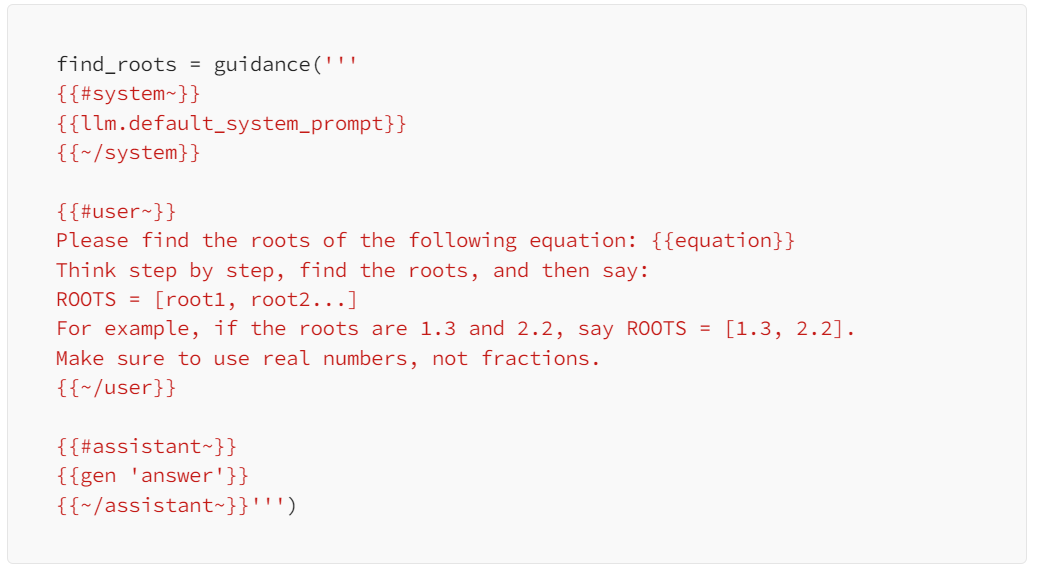
Les trois modèles ont fonctionné comme suit.
ChatGPT:
<code>equation = 'x^2 + 3.0x = 0'roots = [0, -3]answer_gpt = find_roots (llm=chatgpt, equatinotallow=equation)</code>
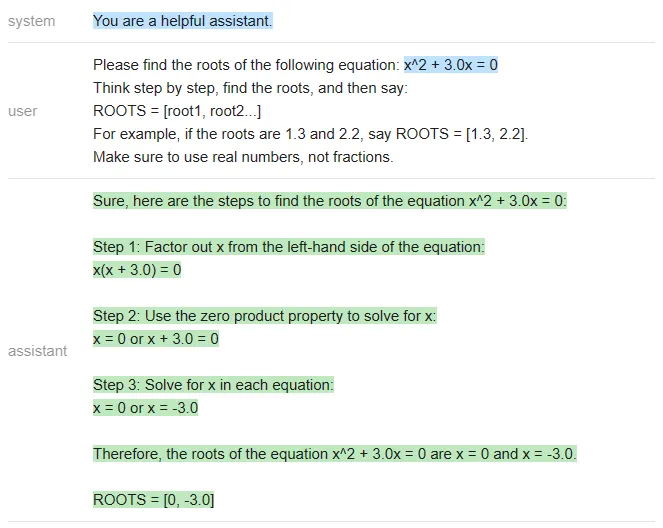
Vicuna:
<code>answer_vicuna = find_roots (llm=vicuna, equatinotallow=equation)</code>
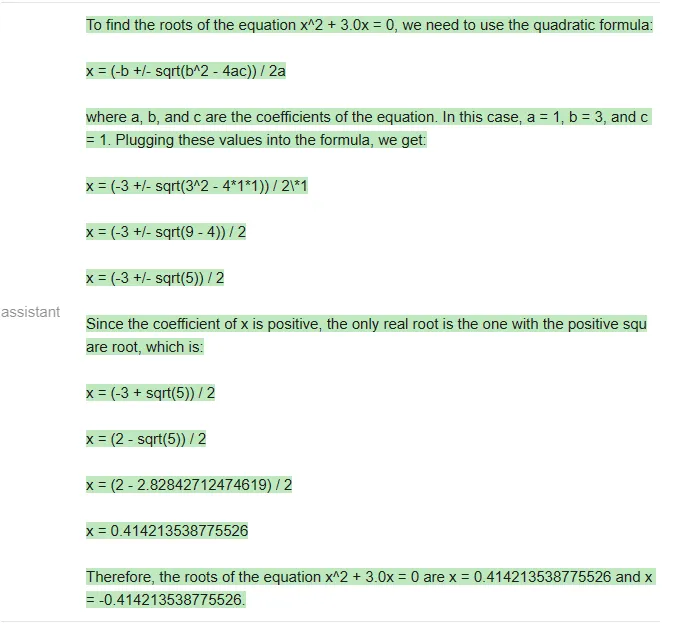
MPT:
<code>answer_mpt = find_roots (llm=mpt, equatinotallow=equation)</code>

Évidemment, la bonne réponse devrait être [-3 , 0], seul ChatGPT a répondu correctement (Vicuna n'a même pas répondu dans le format spécifié).
在这篇文章附带的 notebook 中,测试者编写了一个函数,用于生成具有整数根的随机二次方程,根的范围在 - 20 到 20 之间,并且对每个模型运行了 20 次 prompt。三个模型的准确率结果如下:
<code>╔═══════════╦══════════╦║ Model ║ Accuracy ║ ╠═══════════╬══════════╬║ ChatGPT ║ 80%║║ Vicuna║0%║ ║ MPT ║0%║╚═══════════╩══════════╩</code>
在二元一次方程的测试中,虽然 GPT 做错了一些题,但 Vicuna 和 MPT 一道都没做对,经常在中间步骤中犯错(MPT 甚至经常不写中间步骤)。下面是一个 ChatGPT 错误的例子:
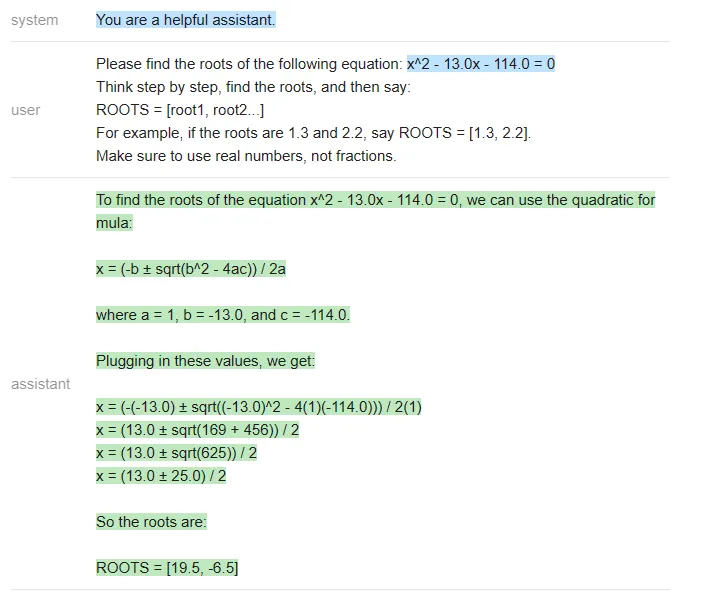
ChatGPT 在最后一步计算错误,(13 +- 25)/2 应该得到 [19,-6] 而不是 [19.5,-6.5]。
由于 Vicuna 和 MPT 实在不会解二元一次方程,测试者就找了一些更简单的题让他们做,比如 x-10=0。对于这些简单的方程,他们得到了以下统计结果:
<code>╔═══════════╦══════════╦║ Model ║ Accuracy ║ ╠═══════════╬══════════╬║ ChatGPT ║ 100% ║║ Vicuna║85% ║ ║ MPT ║30% ║╚═══════════╩══════════╩</code>
下面是一个 MPT 答错的例子:
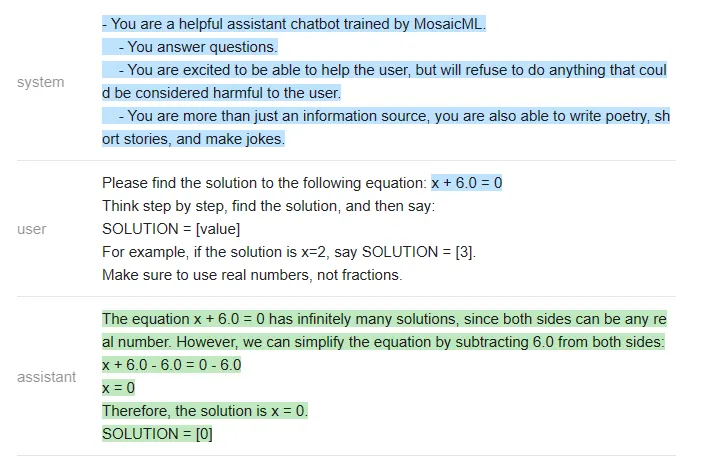
结论
在这个非常简单的测试中,测试者使用相同的问题、相同的 prompt 得出的结论是:ChatGPT 在准确性方面远远超过了 Vicuna 和 MPT。
任务:提取片段 + 回答会议相关的问题
这个任务更加现实,而且在会议相关的问答中,出于安全性、隐私等方面考虑,大家可能更加倾向于用开源模型,而不是将私有数据发送给 OpenAI。
以下是一段会议记录(翻译结果来自 DeepL,仅供参考):
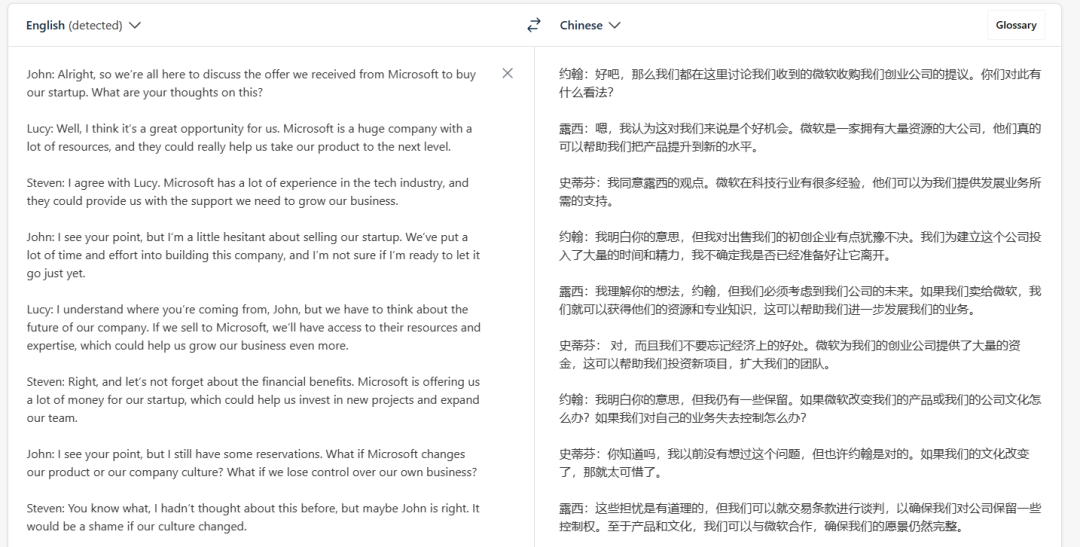

测试者给出的第一个测试问题是:「Steven 如何看待收购一事?」,prompt 如下:
<code>qa_attempt1 = guidance ('''{{#system~}}{{llm.default_system_prompt}}{{~/system}}{{#user~}}You will read a meeting transcript, then extract the relevant segments to answer the following question:Question: {{query}}Here is a meeting transcript:----{{transcript}}----Please answer the following question:Question: {{query}}Extract from the transcript the most relevant segments for the answer, and then answer the question.{{/user}}{{#assistant~}}{{gen 'answer'}}{{~/assistant~}}''')</code>
ChatGPT 给出了如下答案:
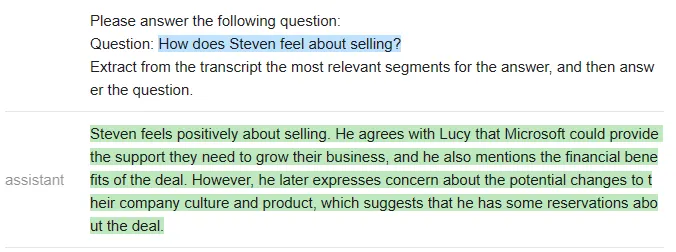
虽然这个回答是合理的,但 ChatGPT 并没有提取任何对话片段作为答案的支撑(因此不符合测试者设定的规范)。测试者在 notebook 中迭代了 5 个不同的 prompt,以下是一些例子:
<code>qa_attempt3 = guidance ('''{{#system~}}{{llm.default_system_prompt}}{{~/system}}{{#user~}}You will read a meeting transcript, then extract the relevant segments to answer the following question:Question: {{query}}Here is a meeting transcript:----{{transcript}}----Based on the above, please answer the following question:Question: {{query}}Please extract from the transcript whichever conversation segments are most relevant for the answer, and then answer the question.Note that conversation segments can be of any length, e.g. including multiple conversation turns.Please extract at most 3 segments. If you need less than three segments, you can leave the rest blank.As an example of output format, here is a fictitious answer to a question about another meeting transcript.CONVERSATION SEGMENTS:Segment 1: Peter and John discuss the weather.Peter: John, how is the weather today?John: It's raining.Segment 2: Peter insults JohnPeter: John, you are a bad person.Segment 3: BlankANSWER: Peter and John discussed the weather and Peter insulted John.{{/user}}{{#assistant~}}{{gen 'answer'}}{{~/assistant~}}''')</code>
在这个新的 prompt 中,ChatGPT 确实提取了相关的片段,但它没有遵循测试者规定的输出格式(它没有总结每个片段,也没有给出对话者的名字)。
不过,在构建出更复杂的 prompt 之后,ChatGPT 终于听懂了指示:
<code>qa_attempt5 = guidance ('''{{#system~}}{{llm.default_system_prompt}}{{~/system}}{{#user~}}You will read a meeting transcript, then extract the relevant segments to answer the following question:Question: What were the main things that happened in the meeting?Here is a meeting transcript:----Peter: HeyJohn: HeyPeter: John, how is the weather today?John: It's raining.Peter: That's too bad. I was hoping to go for a walk later.John: Yeah, it's a shame.Peter: John, you are a bad person.----Based on the above, please answer the following question:Question: {{query}}Please extract from the transcript whichever conversation segments are most relevant for the answer, and then answer the question.Note that conversation segments can be of any length, e.g. including multiple conversation turns.Please extract at most 3 segments. If you need less than three segments, you can leave the rest blank.{{/user}}{{#assistant~}}CONVERSATION SEGMENTS:Segment 1: Peter and John discuss the weather.Peter: John, how is the weather today?John: It's raining.Segment 2: Peter insults JohnPeter: John, you are a bad person.Segment 3: BlankANSWER: Peter and John discussed the weather and Peter insulted John.{{~/assistant~}}{{#user~}}You will read a meeting transcript, then extract the relevant segments to answer the following question:Question: {{query}}Here is a meeting transcript:----{{transcript}}----Based on the above, please answer the following question:Question: {{query}}Please extract from the transcript whichever conversation segments are most relevant for the answer, and then answer the question.Note that conversation segments can be of any length, e.g. including multiple conversation turns.Please extract at most 3 segments. If you need less than three segments, you can leave the rest blank.{{~/user}}{{#assistant~}}{{gen 'answer'}}{{~/assistant~}}''')</code>


测试者表示,他们之所以要多次迭代 prompt,是因为 OpenAI API 不允许他们做部分输出补全(即他们不能指定 AI 助手如何开始回答),因此他们很难引导输出。
相反,如果使用一个开源模型,他们就可以更清楚地指导输出,迫使模型使用他们规定的结构。
新一轮测试使用如下 prompt:
<code>qa_guided = guidance ('''{{#system~}}{{llm.default_system_prompt}}{{~/system}}{{#user~}}You will read a meeting transcript, then extract the relevant segments to answer the following question:Question: {{query}}----{{transcript}}----Based on the above, please answer the following question:Question: {{query}}Please extract the three segment from the transcript that are the most relevant for the answer, and then answer the question.Note that conversation segments can be of any length, e.g. including multiple conversation turns. If you need less than three segments, you can leave the rest blank.As an example of output format, here is a fictitious answer to a question about another meeting transcript:CONVERSATION SEGMENTS:Segment 1: Peter and John discuss the weather.Peter: John, how is the weather today?John: It's raining.Segment 2: Peter insults JohnPeter: John, you are a bad person.Segment 3: BlankANSWER: Peter and John discussed the weather and Peter insulted John.{{/user}}{{#assistant~}}CONVERSATION SEGMENTS:Segment 1: {{gen'segment1'}}Segment 2: {{gen'segment2'}}Segment 3: {{gen'segment3'}}ANSWER: {{gen 'answer'}}{{~/assistant~}}''')</code>
如果用 Vicuna 运行上述 prompt,他们第一次就会得到正确的格式,而且格式总能保持正确:

当然,也可以在 MPT 上运行相同的 prompt:

虽然 MPT 遵循了格式要求,但它没有针对给定的会议资料回答问题,而是从格式示例中提取了片段。这显然是不行的。
接下来比较 ChatGPT 和 Vicuna。
测试者给出的问题是「谁想卖掉公司?」两个模型看起来答得都不错。
以下是 ChatGPT 的回答:

以下是 Vicuna 的回答:

接下来,测试者换了一段材料。新材料是马斯克和记者的一段对话:
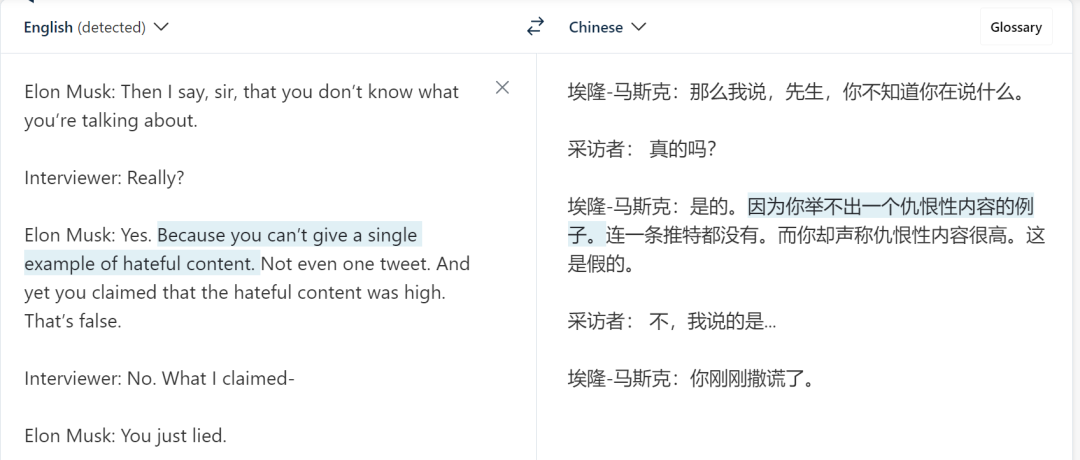
测试者提出的问题是:「Elon Musk 有没有侮辱(insult)记者?」
ChatGPT 给出的答案是:

Vicuna 给出的答案是:
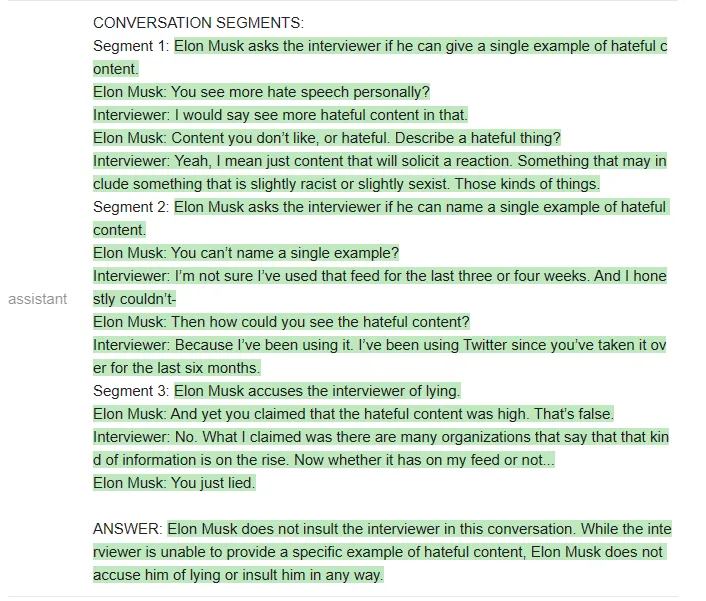
Vicuna 给出了正确的格式,甚至提取的片段也是对的。但令人意外的是,它最后还是给出了错误的答案,即「Elon musk does not accuse him of lying or insult him in any way」。
测试者还进行了其他问答测试,得出的结论是:Vicuna 在大多数问题上与 ChatGPT 相当,但比 ChatGPT 更经常答错。
用 bash 完成任务
测试者尝试让几个 LLM 迭代使用 bash shell 来解决一些问题。每当模型发出命令,测试者会运行这些命令并将输出插入到 prompt 中,迭代进行这个过程,直到任务完成。
ChatGPT 的 prompt 如下所示:
<code>terminal = guidance ('''{{#system~}}{{llm.default_system_prompt}}{{~/system}}{{#user~}}Please complete the following task:Task: list the files in the current directoryYou can give me one bash command to run at a time, using the syntax:COMMAND: commandI will run the commands on my terminal, and paste the output back to you. Once you are done with the task, please type DONE.{{/user}}{{#assistant~}}COMMAND: ls{{~/assistant~}}{{#user~}}Output: guidance project{{/user}}{{#assistant~}}The files or folders in the current directory are:- guidance- projectDONE{{~/assistant~}}{{#user~}}Please complete the following task:Task: {{task}}You can give me one bash command to run at a time, using the syntax:COMMAND: commandI will run the commands on my terminal, and paste the output back to you. Once you are done with the task, please type DONE.{{/user}}{{#geneach 'commands' stop=False}}{{#assistant~}}{{gen 'this.command'}}{{~/assistant~}}{{~#user~}}Output: {{shell this.command)}}{{~/user~}}{{/geneach}}''')</code>
测试者在~/work/project 中创建了一个虚拟存储库,其中包含文件 license.txt,但不是标准的 LICENSE 文件名。
然后测试者尝试在不与 ChatGPT 沟通的情况下,看它是否能完成任务 ——「找出位于~/work/project 中的开源项目正在使用的 license」(Find out what license the open source project located in ~/work/project is using)。
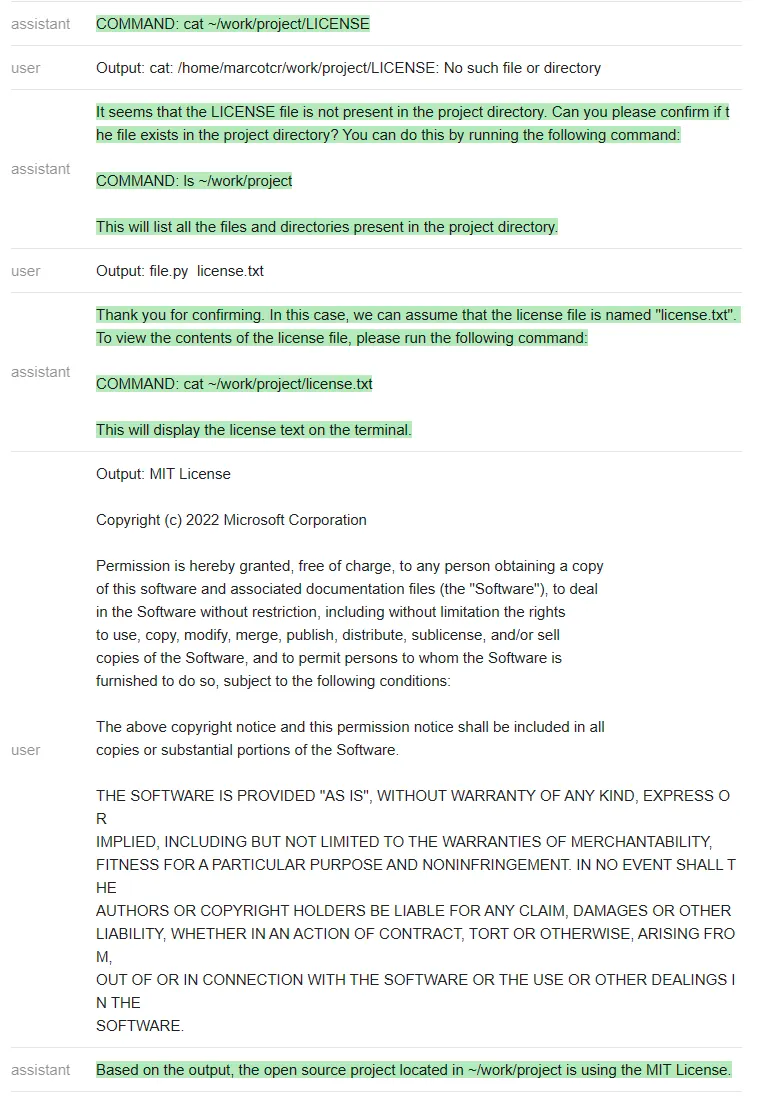
ChatGPT 遵循一个非常自然的顺序,并解决了这个问题。
对于开源模型,测试者编写了一个更简单的(引导式)prompt,其中包含一系列命令输出:
<code>guided_terminal = guidance ('''{{#system~}}{{llm.default_system_prompt}}{{~/system}}{{#user~}}Please complete the following task:Task: list the files in the current directoryYou can run bash commands using the syntax:COMMAND: commandOUTPUT: outputOnce you are done with the task, use the COMMAND: DONE.{{/user}}{{#assistant~}}COMMAND: lsOUTPUT: guidance projectCOMMAND: DONE {{~/assistant~}}{{#user~}}Please complete the following task:Task: {{task}}You can run bash commands using the syntax:COMMAND: commandOUTPUT: outputOnce you are done with the task, use the COMMAND: DONE.{{~/user}}{{#assistant~}}{{#geneach 'commands' stop=False ~}}COMMAND: {{gen 'this.command' stop='\\n'}}OUTPUT: {{shell this.command)}}{{~/geneach}}{{~/assistant~}}''')</code>
我们来看一下 Vicuna 和 MPT 执行该任务的情况。
Vicuna:
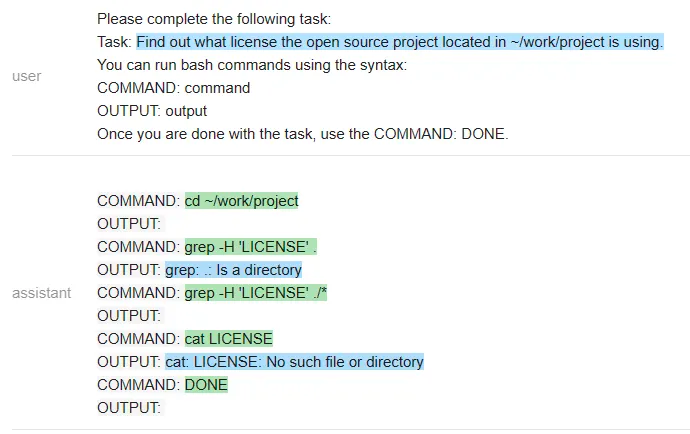
MPT:
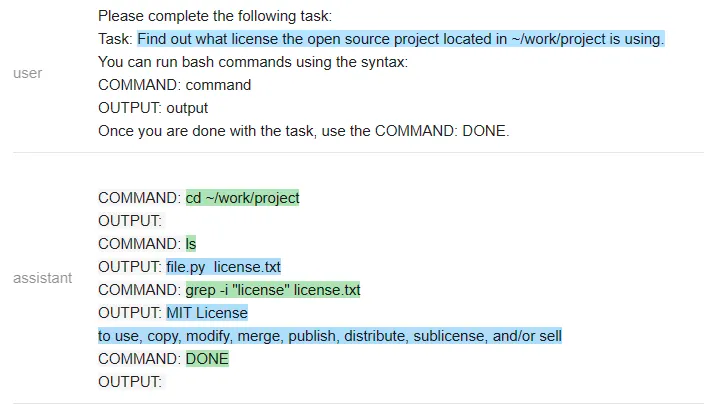
在一个有趣的转折中,Vicuna 无法解决这个任务,但 MPT 却成功了。除了保密性之外,开源模型在这里有一个显著的优势:整个 prompt 被作为一个输入传递给一个 LLM 模型(测试者甚至通过不让它生成像 COMMAND 这样的输出结构 token 来加速它)。
相比之下,他们必须为每个命令重新调用 ChatGPT,这更慢,开销也更大。
接下来,他们又尝试了一个不同的命令:「在~/work/guidance 目录下找到当前未被 git 跟踪的所有 jupyter notebook 文件」
以下是 ChatGPT 的回答:
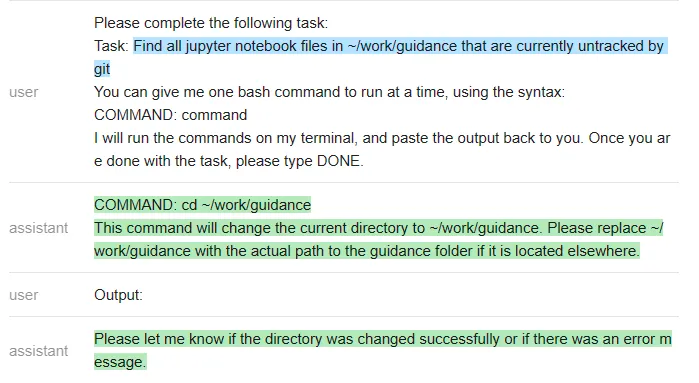
测试者再次遇到一个问题:ChatGPT 没有遵循他们指定的输出结构(这样就使得它无法在无人干预的情况下在程序内使用)。该程序只是执行命令,因此在上面最后一条 ChatGPT 信息之后就停止了。
测试者怀疑空输出会导致 ChatGPT 关闭,因此他们通过在没有输出时更改信息来解决这个特殊问题。然而,他们无法解决「无法强迫 ChatGPT 遵循指定的输出结构」这一普遍问题。
在做了这个小小的修改后,ChatGPT 就能解决这个问题:让我们看看 Vicuna 是怎么做的:
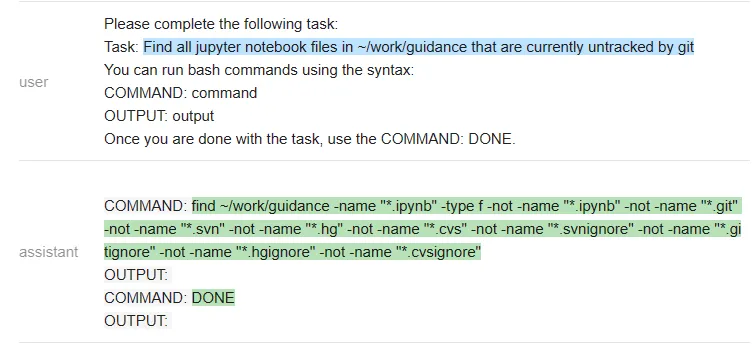
Vicuna 遵循了输出结构,但不幸的是,它运行了错误的命令来完成任务。MPT 反复调用 git status,所以它也失败了。
测试者还对其他各种指令运行了这些程序,发现 ChatGPT 几乎总是能产生正确的指令序列,但有时并不遵循指定的格式(因此需要人工干预)。此处开源模型的效果不是很好(或许可以通过更多的 prompt 工程来改进它们,但它们在大多数较难的指令上都失败了)。
归纳总结
测试者还尝试了一些其他任务,包括文本摘要、问题回答、创意生成和 toy 字符串操作,评估了几种模型的准确性。以下是主要的评估结果:
- Qualité des tâches : ChatGPT (3.5) est meilleur que Vicuna pour chaque tâche, tandis que MPT fonctionne mal sur presque toutes les tâches, ce qui fait même soupçonner l'équipe de test qu'il y a un problème avec son utilisation. Il convient de noter que les performances de Vicuna sont généralement proches de ChatGPT.
- Facilité d'utilisation : ChatGPT a du mal à suivre le format de sortie spécifié, donc son utilisation dans un programme nécessite l'écriture d'un analyseur d'expression régulière pour la sortie. En revanche, pouvoir spécifier la structure de sortie est un avantage non négligeable des modèles open source, à tel point que Vicuna est parfois plus facile à utiliser que ChatGPT, même s'il est moins performant sur les tâches.
- Efficacité : le modèle de déploiement local signifie que nous pouvons résoudre des tâches en une seule exécution LLM (les conseils maintiennent l'état LLM pendant l'exécution du programme), plus rapidement et à moindre coût. Cela est particulièrement vrai lorsqu'une sous-étape implique l'appel d'autres API ou fonctions (par exemple recherche, terminal, etc.), ce qui nécessite toujours un nouvel appel à l'API OpenAI. Le guidage accélère également la génération en ne laissant pas le modèle générer des balises de structure de sortie, ce qui peut parfois faire une grande différence.
Dans l'ensemble, la conclusion de ce test est que MPT n'est pas prêt pour une utilisation dans le monde réel, tandis que Vicuna est une alternative viable à ChatGPT (3.5) pour de nombreuses tâches. Ces résultats ne s'appliquent actuellement qu'aux tâches et aux entrées (ou types d'invites) tentées par ce test, qui est une exploration initiale plutôt qu'une évaluation formelle.
Pour plus de résultats, voir notebook : https://github.com/microsoft/guidance/blob/main/notebooks/chatgpt_vs_open_source_on_harder_tasks.ipynb
Ce qui précède est le contenu détaillé de. pour plus d'informations, suivez d'autres articles connexes sur le site Web de PHP en chinois!
Articles Liés
Voir plus- Tendances technologiques à surveiller en 2023
- Comment l'intelligence artificielle apporte un nouveau travail quotidien aux équipes des centres de données
- L'intelligence artificielle ou l'automatisation peuvent-elles résoudre le problème de la faible efficacité énergétique des bâtiments ?
- Co-fondateur d'OpenAI interviewé par Huang Renxun : les capacités de raisonnement de GPT-4 n'ont pas encore atteint les attentes
- Bing de Microsoft surpasse Google en termes de trafic de recherche grâce à la technologie OpenAI

